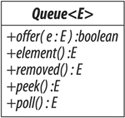Chapter 14. Queues
| A queue is a collection designed to hold elements for processing, yielding them up in the order in which they are to be processed. The corresponding Collections Framework interface Queue (see Figure 14.1) has a number of different implementations embodying different rules about what this order should be. Many of the implementations use the rule that tasks are to be processed in the order in which they were submitted (First In First Out, or FIFO), but other rules are possiblefor example, the Collections Framework includes queue classes whose processing order is based on task priority. The Queue interface was introduced in Java 5, motivated in part by the need for queues in the concurrency utilities included in that release. A glance at the hierarchy of implementations shown in Figure 14.2 shows that, in fact, nearly all of the Queue implementations in the Collections Framework are in the package java.util.concurrent. Figure 14-1. Queue Figure 14-2. Implementations of Queue in the Collections Framework One classic requirement for queues in concurrent systems comes when a number of tasks have to be executed by a number of threads working in parallel. An everyday example of this situation is that of a single queue of airline passengers being handled by a line of check-in operators. Each operator works on processing a single passenger (or a group of passengers) while the remaining passengers wait in the queue. As they arrive, passengers join the tail of the queue, wait until they reach its head, and are then assigned to the next operator who becomes free. A good deal of fine detail is involved in implementing a queue such as this; operators have to be prevented from simultaneously attempting to process the same passenger, empty queues have to be handled correctly, and in computer systems there has to be a way of defining queues with a maximum size, or bound. (This last requirement may not often be imposed in airline terminals, but it can be very useful in systems in which there is a maximum waiting time for a task to be executed.) The Queue implementations in java.util.concurrent look after these implementation details for you. In addition to the operations inherited from Collection, the Queue interface includes operations to add an element to the tail of the queue, to inspect the element at its head, or to remove the element at its head. Each of these three operations comes in two varieties, one which returns a value to indicate failure and one which throws an exception. Adding an Element to a Queue The exception-throwing variant of this operation is the add method inherited from Collection. Although add does return a boolean signifying its success in inserting an element, that value can't be used to report that a bounded queue is full; the contract for add specifies that it may return false only if the collection refused the element because it was already presentotherwise, it must throw an exception. The value-returning variant is offer: boolean offer(E e) // insert the given element if possible The value returned by offer indicates whether the element was successfully inserted or not. Note that offer does throw an exception if the element is illegal in some way (for example, the value null for a queue that doesn't permit nulls). Normally, if offer returns false, it has been called on a bounded queue that has reached capacity. Retrieving an Element from a Queue The methods in this group are peek and element for inspecting the head element, and poll and remove for removing it from the queue and returning its value. The methods that throw an exception for an empty queue are: E element() // retrieve but do not remove the head element E remove() // retrieve and remove the head element Notice that this is a different method from the Collection method remove(Object). The methods that return null for an empty queue are: E peek() // retrieve but do not remove the head element E poll() // retrieve and remove the head element Because these methods return null to signify that the queue is empty, you should avoid using null as a queue element. In general, the use of null as a queue element is discouraged by the Queue interface, and the only standard implementation that allows it is the legacy implementation LinkedList. |
EAN: 2147483647
Pages: 136